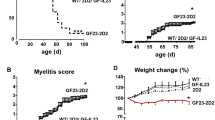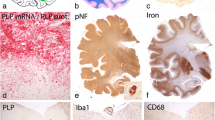Abstract
Multiple sclerosis is a demyelinating autoimmune disease of the CNS. Its animal model experimental autoimmune encephalomyelitis is commonly induced by active immunization with myelin antigens. To investigate human immune responses against myelin antigens in vivo we established a new subclinical experimental autoimmune encephalomyelitis model in humanized mice. NOD/Scidγc−/− animals were transferred with peripheral blood mononuclear cells from healthy human donors and immunized with myelin antigens in complete Freund’s adjuvant and antigen-pulsed autologous dendritic cells. Human T cells recovered from these animals reacted specifically to the soluble domain of myelin oligodendrocyte glycoprotein and secreted proinflammatory cytokines. Furthermore, immunized animals developed subclinical CNS inflammation with infiltrating CD4+ and CD8+ T cells and production of encephalitogenic cytokines. Thus, this model of myelin-induced CNS inflammation by human T cells may allow testing of new human-specific therapeuticals for multiple sclerosis.





Similar content being viewed by others
Abbreviations
- GvHD:
-
graft-versus-host disease
- NSG:
-
NOD/Scidγc−/−
- moDCs:
-
monocyte-derived dendritic cells
- MOG:
-
myelin oligodendrocyte glycoprotein
- Iba1:
-
ionized calcium binding adaptor molecule 1
References
Ajami B, Bennett JL, Krieger C, McNagny KM, Rossi FM (2011) Infiltrating monocytes trigger EAE progression, but do not contribute to the resident microglia pool. Nat Neurosci 14(9):1142–1149
Babbe H, Roers A, Waisman A, Lassmann H, Goebels N, Hohlfeld R, Friese M et al (2000) Clonal expansions of CD8(+) T cells dominate the T cell infiltrate in active multiple sclerosis lesions as shown by micromanipulation and single cell polymerase chain reaction. J Exp Med 192:393–404
Balazs AB, Chen J, Hong CM, Rao DS, Yang L, Baltimore D (2012) Antibody-based protection against HIV infection by vectored immunoprophylaxis. Nature 481(7379):81–84
Becker C, Taube C, Bopp T, Michel K, Kubach J, Reuter S et al (2009) Protection from graft-versus-host disease by HIV-1 envelope protein gp120-mediated activation of human CD4 + CD25+ regulatory T cells. Blood 114(6):1263–1269
Bernard CC, Johns TG, Slavin A, Ichikawa M, Ewing C, Liu J et al (1997) Myelin oligodendrocyte glycoprotein: a novel candidate autoantigen in multiple sclerosis. J Mol Med 75(2):77–88
Brehm MA, Cuthbert A, Yang C, Miller DM, DiIorio P, Laning J et al (2010) Parameters for establishing humanized mouse models to study human immunity: analysis of human hematopoietic stem cell engraftment in three immunodeficient strains of mice bearing the IL2rgamma(null) mutation. Clin Immunol 135(1):84–98
Bruno R, Sabater L, Sospedra M, Ferrer-Francesch X, Escudero D, Martinez-Caceres E et al (2002) Multiple sclerosis candidate autoantigens except myelin oligodendrocyte glycoprotein are transcribed in human thymus. Eur J Immunol 32(10):2737–2747
Cardona AE, Huang D, Sasse ME, Ransohoff RM (2006) Isolation of murine microglial cells for RNA analysis or flow cytometry. Nat Protoc 1(4):1947–1951
Codarri L, Gyulveszi G, Tosevski V, Hesske L, Fontana A, Magnenat L et al (2011) RORgammat drives production of the cytokine GM-CSF in helper T cells, which is essential for the effector phase of autoimmune neuroinflammation. Nat Immunol 12(6):560–567
Constantinescu CS, Farooqi N, O’Brien K, Gran B (2011) Experimental autoimmune encephalomyelitis (EAE) as a model for multiple sclerosis (MS). Br J Pharmacol 164(4):1079–1106
Croxford AL, Kurschus FC, Waisman A (2011) Mouse models for multiple sclerosis: Historical facts and future implications. Biochim Biophys Acta 1812(2):177–183
El-Behi M, Ciric B, Dai H, Yan Y, Cullimore M, Safavi F et al (2011) The encephalitogenicity of T(H)17 cells is dependent on IL-1- and IL-23-induced production of the cytokine GM-CSF. Nat Immunol 12(6):568–575
Friese MA, Montalban X, Willcox N, Bell JI, Martin R, Fugger L (2006) The value of animal models for drug development in multiple sclerosis. Brain 129(Pt 8):1940–1952
Harui A, Kiertscher SM, Roth MD (2011) Reconstitution of huPBL-NSG mice with donor-matched dendritic cells enables antigen-specific T-cell activation. J Neuroimmune Pharmacol 6(1):148–157
Iglesias A, Bauer J, Litzenburger T, Schubart A, Linington C (2001) T- and B-cell responses to myelin oligodendrocyte glycoprotein in experimental autoimmune encephalomyelitis and multiple sclerosis. Glia 36(2):220–234
Jonuleit H, Kuhn U, Muller G, Steinbrink K, Paragnik L, Schmitt E et al (1997) Pro-inflammatory cytokines and prostaglandins induce maturation of potent immunostimulatory dendritic cells under fetal calf serum-free conditions. Eur J Immunol 27(12):3135–3142
Jonuleit H, Schmitt E, Schuler G, Knop J, Enk AH (2000) Induction of interleukin 10-producing, nonproliferating CD4(+) T cells with regulatory properties by repetitive stimulation with allogeneic immature human dendritic cells. J Exp Med 192(9):1213–1222
Kamath AT, Henri S, Battye F, Tough DF, Shortman K (2002) Developmental kinetics and lifespan of dendritic cells in mouse lymphoid organs. Blood 100(5):1734–1741
King IL, Dickendesher TL, Segal BM (2009) Circulating Ly-6C + myeloid precursors migrate to the CNS and play a pathogenic role during autoimmune demyelinating disease. Blood 113(14):3190–3197
King M, Pearson T, Shultz LD, Leif J, Bottino R, Trucco M et al (2008) A new Hu-PBL model for the study of human islet alloreactivity based on NOD-scid mice bearing a targeted mutation in the IL-2 receptor gamma chain gene. Clin Immunol 126(3):303–314
Krishnamoorthy G, Saxena A, Mars LT, Domingues HS, Mentele R, Ben-Nun A et al (2009) Myelin-specific T cells also recognize neuronal autoantigen in a transgenic mouse model of multiple sclerosis. Nat Med 15(6):626–632
Kumar P, Ban HS, Kim SS, Wu H, Pearson T, Greiner DL et al (2008) T cell-specific siRNA delivery suppresses HIV-1 infection in humanized mice. Cell 134(4):577–586
Kurschus FC, Wortge S, Waisman A (2011) Modeling a complex disease: multiple sclerosis. Adv Immunol 110:111–137
Lagasse E, Weissman IL (1997) Enforced expression of Bcl-2 in monocytes rescues macrophages and partially reverses osteopetrosis in op/op mice. Cell 89(7):1021–1031
Lindert RB, Haase CG, Brehm U, Linington C, Wekerle H, Hohlfeld R (1999) Multiple sclerosis: B- and T-cell responses to the extracellular domain of the myelin oligodendrocyte glycoprotein. Brain: J Neurol 122(Pt 11):2089–2100
Linington C, Bradl M, Lassmann H, Brunner C, Vass K (1988) Augmentation of demyelination in rat acute allergic encephalomyelitis by circulating mouse monoclonal antibodies directed against a myelin/oligodendrocyte glycoprotein. Am J Pathol 130(3):443–454
Livak KJ, Schmittgen TD (2001) Analysis of relative gene expression data using real-time quantitative PCR and the 2(−Delta Delta C(T)) Method. Methods 25(4):402–408
Lucchinetti C, Bruck W, Parisi J, Scheithauer B, Rodriguez M, Lassmann H (2000) Heterogeneity of multiple sclerosis lesions: implications for the pathogenesis of demyelination. Ann Neurol 47(6):707–717
Martin H, Reuter S, Dehzad N, Heinz A, Bellinghausen I, Saloga J et al (2012) CD4-mediated regulatory T-cell activation inhibits the development of disease in a humanized mouse model of allergic airway disease. J Allergy Clin Immunol 129(2):521–528, 528 e521-527
Mestas J, Hughes CC (2004) Of mice and not men: differences between mouse and human immunology. J Immunol 172(5):2731–2738
Mosier DE, Gulizia RJ, Baird SM, Wilson DB (1988) Transfer of a functional human immune system to mice with severe combined immunodeficiency. Nature 335(6187):256–259
Pette M, Fujita K, Wilkinson D, Altmann DM, Trowsdale J, Giegerich G et al (1990) Myelin autoreactivity in multiple sclerosis: recognition of myelin basic protein in the context of HLA-DR2 products by T lymphocytes of multiple-sclerosis patients and healthy donors. Proc Natl Acad Sci U S A 87(20):7968–7972
Pöllinger B, Krishnamoorthy G, Berer K, Lassmann H, Bosl MR, Dunn R et al (2009) Spontaneous relapsing-remitting EAE in the SJL/J mouse: MOG-reactive transgenic T cells recruit endogenous MOG-specific B cells. J Exp Med 206(6):1303–1316
Roep BO, Buckner J, Sawcer S, Toes R, Zipp F (2012) The problems and promises of research into human immunology and autoimmune disease. Nat Med 18(1):48–53
Sawcer S, Hellenthal G, Pirinen M, Spencer CC, Patsopoulos NA, Moutsianas L et al (2011) Genetic risk and a primary role for cell-mediated immune mechanisms in multiple sclerosis. Nature 476(7359):214–219
Schluesener HJ, Wekerle H (1985) Autoaggressive T lymphocyte lines recognizing the encephalitogenic region of myelin basic protein: in vitro selection from unprimed rat T lymphocyte populations. J Immunol 135(5):3128–3133
Shultz LD, Ishikawa F, Greiner DL (2007) Humanized mice in translational biomedical research. Nat Rev Immunol 7(2):118–130
Sonar SS, Hsu YM, Conrad ML, Majeau GR, Kilic A, Garber E et al (2010) Antagonism of TIM-1 blocks the development of disease in a humanized mouse model of allergic asthma. J Clin Investig 120(8):2767–2781
Soulika AM, Lee E, McCauley E, Miers L, Bannerman P, Pleasure D (2009) Initiation and progression of axonopathy in experimental autoimmune encephalomyelitis. J Neurosci: Off J Soc Neurosci 29(47):14965–14979
Steinman L, Zamvil SS (2006) How to successfully apply animal studies in experimental allergic encephalomyelitis to research on multiple sclerosis. Ann Neurol 60(1):12–21
Suntharalingam G, Perry MR, Ward S, Brett SJ, Castello-Cortes A, Brunner MD et al (2006) Cytokine storm in a phase 1 trial of the anti-CD28 monoclonal antibody TGN1412. N Engl J Med 355(10):1018–1028
t Hart BA, Gran B, Weissert R (2011) EAE: imperfect but useful models of multiple sclerosis. Trends Mol Med 17(3):119–125
van Rijn RS, Simonetti ER, Hagenbeek A, Hogenes MC, de Weger RA, Canninga-van Dijk MR et al (2003) A new xenograft model for graft-versus-host disease by intravenous transfer of human peripheral blood mononuclear cells in RAG2−/− gammac−/− double-mutant mice. Blood 102(7):2522–2531
Wekerle H, Flugel A, Fugger L, Schett G, Serreze D (2012) Autoimmunity’s next top models. Nature Med 18(1):66–70
Wekerle H, Kurschus FC (2006) Animal models of multiple sclerosis. Drug Disc Today: Dis Models 3(4):359–367
Wiendl H, Hohlfeld R (2009) Multiple sclerosis therapeutics: unexpected outcomes clouding undisputed successes. Neurology 72(11):1008–1015
Zehntner SP, Brickman C, Bourbonniere L, Remington L, Caruso M, Owens T (2005) Neutrophils that infiltrate the central nervous system regulate T cell responses. J Immunol 174(8):5124–5131
Zhou D, Srivastava R, Nessler S, Grummel V, Sommer N, Bruck W et al (2006) Identification of a pathogenic antibody response to native myelin oligodendrocyte glycoprotein in multiple sclerosis. Proc Natl Acad Sci U S A 103(50):19057–19062
Acknowledgments
We thank André Heinen, Petra Adams and Nicole Roder for excellent technical support. This work was supported by the DFG via TR128 to FK (TP A03) and to AW (TP A07).
Disclosure of conflicts of interest
The authors have no conflict of interest. The manuscript contains a part of the medical thesis of Morad Zayoud.
Author information
Authors and Affiliations
Corresponding author
Additional information
Khalifa El Malki and Katrin Frauenknecht contributed equally.
Electronic supplementary material
Below is the link to the electronic supplementary material.
ESM 1
(PDF 4.10 MB)
Rights and permissions
About this article
Cite this article
Zayoud, M., El Malki, K., Frauenknecht, K. et al. Subclinical CNS Inflammation as Response to a Myelin Antigen in Humanized Mice. J Neuroimmune Pharmacol 8, 1037–1047 (2013). https://doi.org/10.1007/s11481-013-9466-4
Received:
Accepted:
Published:
Issue Date:
DOI: https://doi.org/10.1007/s11481-013-9466-4




